The Samsung Galaxy Note7 (S820) Review
by Joshua Ho on August 16, 2016 9:00 AM ESTSystem Performance Cont'd
Now that we've covered more general purpose benchmarks that tend to emphasize CPU performance and GPU compute performance, we can look at benchmarks that tend to more strongly emphasize things that games will see benefits from such as improved GPU graphics performance and improved CPU physics processing performance.
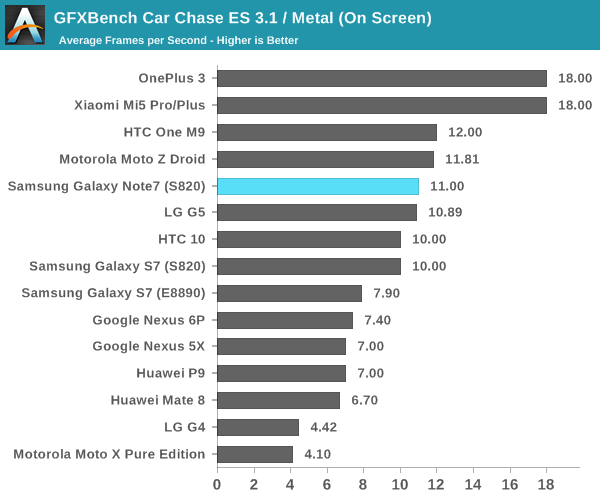
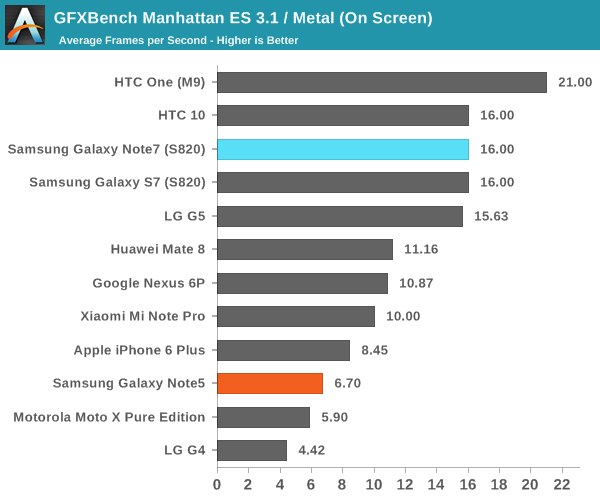
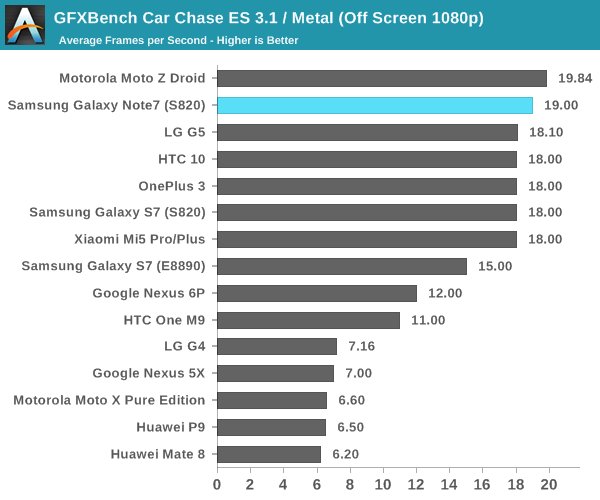
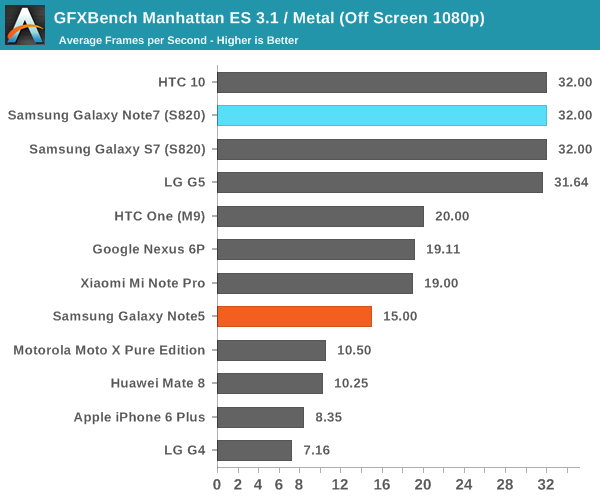

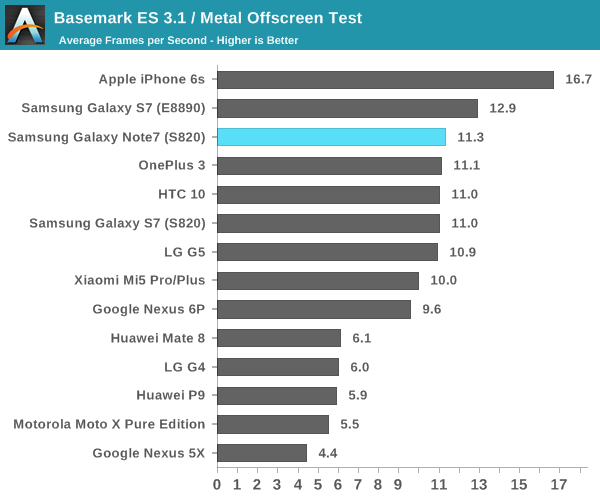
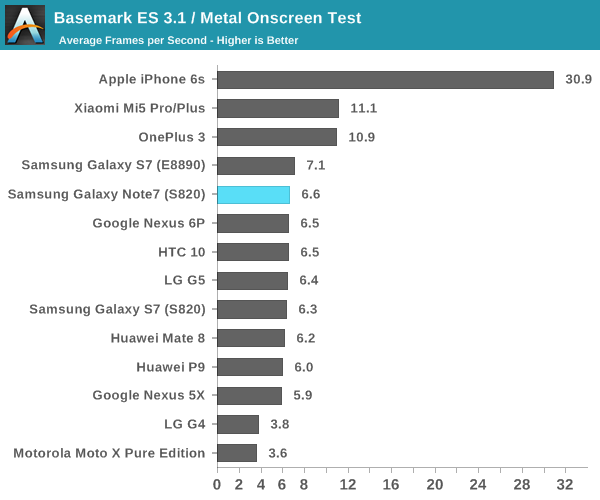
It's probably no surprise, but the Galaxy Note7 performs as expected with the latest drivers and in ideal thermal conditions. The Adreno 530 should be more than sufficient for the forseeable future but for maximum performance it's best to enable 1080p rendering or lower to maximize frame rates in games like Real Racing 3 that tend to really use the GPU to its fullest extent.
NAND Performance
Of course, while Discomark provides a sort of holistic view of performance for a specific task, it’s also important to at least try and break down the various aspects that impact system performance so rather than simple black box testing we can further understand what factors influence performance and therefore provide additional information to make better buying decisions. One of the major contributors to general purpose performance is going to be storage performance, which is often something often ignored by marketing as the nitty gritty details of NAND storage realistically require some background in solid state physics and devices to understand, as well as some understanding of computer science and engineering.
While I’m not really happy with the state of our mobile storage benchmarks, for now I don’t really see another option here as the publicly available storage benchmarks for Android and iOS are fairly basic. Putting aside the state of the benchmarking industry, our current benchmark remains AndroBench 4 which provides at least some basic storage benchmarking capabilities. We use custom settings with this benchmark which attempts to make the test more realistic as the default settings are just wildly unrealistic. This includes adjusting the buffer size, increasing the file size to 100 MB, and only using one thread instead of 8. 256KB file size is targeted as this is the most common block size if you profile this kind of thing for sequential writes and reads, while 4KB block sizes are the most common for other tasks as the vast majority of computer architectures use 4KB pages for virtual memory. Single-threaded I/O is common in most cases because multi-threaded programming is still difficult for most people to reason about in an effective manner because conscious thought is inherently serial in nature with some multiplexing. In addition to this, many eMMC solutions on the market don’t really perform well with multiple threads simultaneously as the controller can’t do anything with extra requests other than reply with a busy signal which already happens with a single thread.
Putting aside discussions of testing we can take a look at the storage solution used in the Galaxy Note7 before getting into the actual results. The Note7 continues to use basically the same storage solution as the Galaxy S7 and S6, which is to say an MLC-based solution that has a UFS Gear 3 single lane interface for bandwidth up to 600 MB/s and basically has the exact same model number if you check the SCSI devices attached to the system save for some changes that indicate the higher 64GB storage relative to the 32GB chips that are most common in the Galaxy S7.
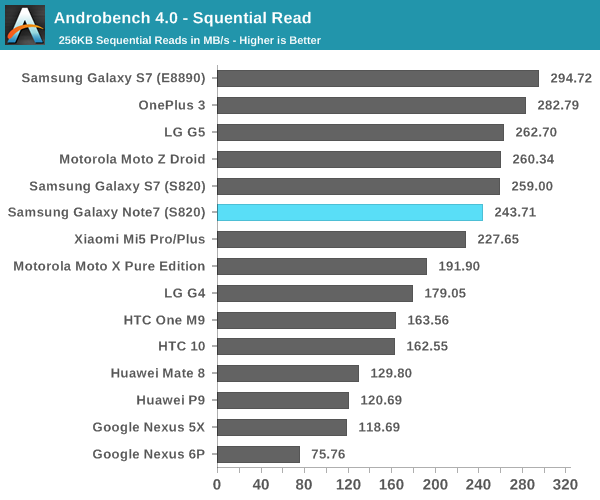

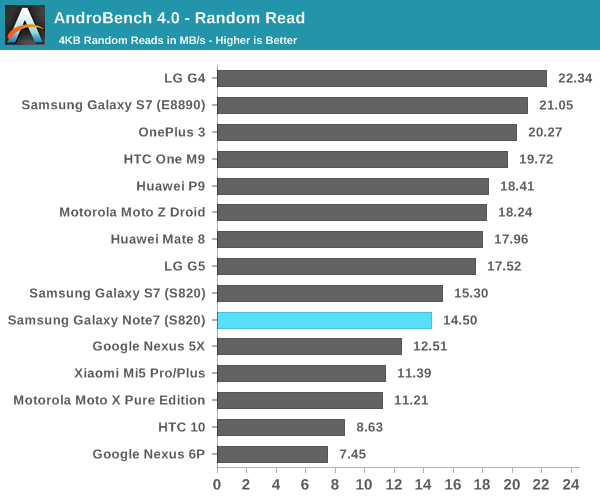
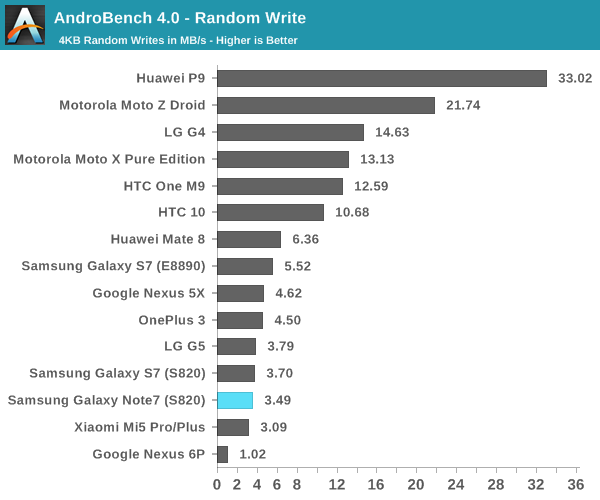
Looking at the test results it performs exactly as quickly as you’d expect from this MLC solution as we’ve tested it in the Galaxy S6, S6 edge, S6 edge+, Note5, S7, S7 edge, and now the Note7 as well as the LG G5. The performance here is acceptable but obviously if you look at burst performance the iPhone 6s has a faster solution due to the hybrid SLC/TLC storage solution. The main benefit of pure MLC NAND is that performance is more consistent as there’s no precipitous drop when the SLC buffer fills. There’s always room to improve but I don’t really see how it’s going to happen unless Samsung moves to V-NAND for the next generation.










202 Comments
View All Comments
erikiksaz - Friday, August 19, 2016 - link
How did you guys manage to monitor for frame drops? Is it a separate app?Belard - Sunday, August 21, 2016 - link
Still rather blah- design. I'm surprised they continue the glass backing from the S6, like as if they have not learned anything from Apple? A family member has the S6 and yes, her back has a spider crack on it with a long one from top to bottom.amdwilliam1985 - Tuesday, August 23, 2016 - link
they need the glass back for the wireless charging.Glass and plastic works with Qi-charging, metal does not(at least for now).
thek - Sunday, August 21, 2016 - link
so no one is going to bring up the facts that this 850$ phone has a smaller battery then the Xiaomi redmi note 3 (a 150$ phone) and it's bootloader is locked in the US which literally makes it just the same as an Iphone. (All of us here came to Android because it was an open garden). Closing android is making Samsung not a legit Apple vendor IMO, and should too for the rest of you.Don't be kids and be fooled by gimmicks and high specs. You can't even get CM13 on this phone.
And a really bad job by the reviewer for not bringing this up. As usual in Anandtech they only cares about numbers and not whats behind them.
thek - Sunday, August 21, 2016 - link
not a legit Android* vendorCSMR - Sunday, August 21, 2016 - link
Great review and phone.I wonder if it would be possible to check the compass in future?
All the phones I have owned have had terrible magnetometers which stop working, require shaking the phone, or are off by a large angle.
Having compass inaccuracies pointed out in reviews would really shake things up.
Pipperox - Sunday, August 21, 2016 - link
So you're slamming an excellent phone (like the S7 as well) because of your non-sensical review of its camera?The most reputable camera review website - Dxomark - puts the S7 at the top for still image quality, on par with the HTC10, and the Samsung is even better in the video score.
What problems do you see with video stabilization?
Dxo Labs talks about "excellent video stabilization", i have an S7 edge and can only confirm what they say.
Diet - Monday, August 22, 2016 - link
This the only review on the internet that addreses the weak points of this overpriced phone.Kudos To Anandtech!
KoolAidMan1 - Monday, August 22, 2016 - link
More performance tests: https://youtu.be/3-61FFoJFy0tldw - The flagship GN7 is slower than a year-old iPhone 6S.
jlabelle2 - Tuesday, August 23, 2016 - link
- The flagship GN7 is slower than a year-old iPhone 6Syes and a Porsche 911 from last year is faster than an Audi RS6. The question is what do you need in your day to day life. Is the speed of the RS6 enough? Do you need space? 5 seats? Comfort? Good equipments?
People have short memory. The iPhone was a success because it was the 1st phone with a big touchscreen, easy to use, with a great experience. Now, people consider that a phone should be choosen only based on the speed difference of launching 30 different applications within 2mn. Even if new phone are twice as quick as the previous one that was twice as quick as the previous previous one that was twice... Well, you see the point. Phones are fast enough.
I do not know anybody that is using an iPhone 6 or Samsung S6 and that is saying: "my phone is too slow and the only thing I would wish is to that a phone twice as quick".
I am certain that if Apple would sell at the same price:
1/ iPhone 7 = CPU of the 6S, AMOLED screen, quick and wireless charging, waterproof, 5,7" screen but 5mm narrower than current 6S+, camera hardware button, pen support.
2/ iPhone 6SS = iPhone 6S with a CPU 50% quicker
you can be absolutely assure that NOBODY would choose an iPhone 6SS versus this hypothetical iPhone 7.
We can be all fair of what Apple is achieving with its iPhone, which is great. But some minimal common sense would be good in this forum.